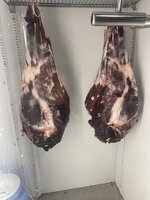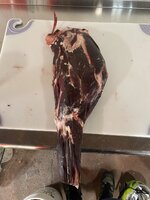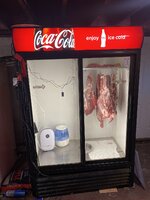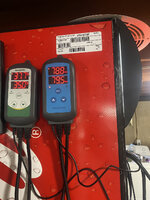We have a polar vortex coming in the next few days so I went ahead and quartered my aging deer while it was not frozen. I put the quarters in a cooler for a day and started cutting it up last night. I will finish tonight. I went 28 days hanging, cut backstraps and shoulders on day 29, and will be doing the hinds tonight on day 30. Meat had a different texture while cutting. The outer layer of silver skin basically peeled right off without having to use a knife. I will be sampling some of this meat this weekend. I am also thinking of better ways to do this process at my house. I am trying to justify the purchase of a small box trailer so I can temporarily partition off a section and add an air conditioner. I will probably not do it but I have had a lot of time to think over the last 30 days.
Navigation
Install the app
How to install the app on iOS
Follow along with the video below to see how to install our site as a web app on your home screen.
Note: This feature may not be available in some browsers.
More options
Style variation
You are using an out of date browser. It may not display this or other websites correctly.
You should upgrade or use an alternative browser.
You should upgrade or use an alternative browser.
The Deer Aging Thread
- Thread starter robby denning
- Start date
thanks for sharing the results.Just realized I never updated this... we did the aged vs non-aged test. Basically, it was all really good. There was a difference between the two, but it wasn't profound. My wife claimed she couldn't really tell a difference. To me the aged cut was definitely less saturated than the non-aged portion. It's difficult to describe, it wasn't dry at all. It was just slightly less red and didn't create a puddle the way the non-aged portion did. Which makes perfect sense considering how long it hung...
Flavor was great for both, the difference in flavor was very subtle. But also keep in mind this was probably a 3.5-year-old doe taken in early December and not some rutted up old buck. Both pieces were extremely tender. I have to imagine the difference would be more profound if this was an animal that wasn't prime for eating.
All that being said, I'm a believer and am already scheming ways to step up my meat aging game for 2021. Not turning back.
You're assumption is correct, the older the animal, the better it seems to work
Yellowriver
FNG
Has anybody tried wet aging? I did some deer loins couple years ago. Just curious if wet and dry aging carry the same taste? I wasn’t over impressed with the wet aging but I had no waste or trimming.
Has anybody tried wet aging? I did some deer loins couple years ago. Just curious if wet and dry aging carry the same taste? I wasn’t over impressed with the wet aging but I had no waste or trimming.
someone further up the thread was commenting on wet aging. seems like good results
Sent from my iPhone using Tapatalk
Pro953
WKR
Not sure if it’s exactly what you guys are speaking of. When possible I pull my Vac sealed cuts and wet age them for a few week before cooking them. I have not pushed if over a month before.
You just have to be comfortable with the cleanliness of your butcher work as I am pretty sure wet age can have some higher risk of “going off” if it’s not kept cool enough.
Not sure it would work with the cut and wrap type of freeze. I guess you could just transfer for a gallon ziplock.
You do not get the flavor concentration like you do with dry age due to the lack of dehydration, but you so gain some tenderness.
Honestly I have not approached this scientifically. Most of my experience developed from wet age by neglect. I would pull things out and then schedules changed and they would sit for a few weeks before we had a chance to cook. The more success I had the more I stated planning for it.
Maybe someday if I get a tough animal and can put a few of the same cuts together and do a side by side, I would be better able to provide data.
Sent from my iPhone using Tapatalk
You just have to be comfortable with the cleanliness of your butcher work as I am pretty sure wet age can have some higher risk of “going off” if it’s not kept cool enough.
Not sure it would work with the cut and wrap type of freeze. I guess you could just transfer for a gallon ziplock.
You do not get the flavor concentration like you do with dry age due to the lack of dehydration, but you so gain some tenderness.
Honestly I have not approached this scientifically. Most of my experience developed from wet age by neglect. I would pull things out and then schedules changed and they would sit for a few weeks before we had a chance to cook. The more success I had the more I stated planning for it.
Maybe someday if I get a tough animal and can put a few of the same cuts together and do a side by side, I would be better able to provide data.
Sent from my iPhone using Tapatalk
Yellowriver
FNG
My wet aging was deer loin cleaned and cut into chops, vac sealed and put in fridge for 21 days. When you open bag don’t sniff the meat. It was tender and had more depth in flavor. Almost earthy. Have not tried it since but what I tried this year was put whole loins in heavy Tupperware and put in fridge for a week before I cut and vac seal. On a side note I took 4 hanging tenders, sliced in strips, added packet of fajita seasoning and some vegetabl oil. By the time they are thawed should be ready for the hot cast iron skillet and some veggies.
thanks for the feedback. How long did you end up aging? And did you age it in quarters or whole? Sorry if you posted it further up on the thread, this thing is getting huge.I sampled some of my aged venison last night. I cooked up a section of backstrap in some butter and olive oil. It was fantastic. The meat was as tender as the tenderloins. I will definitely be doing this with an old mountain buck next.
close enough, once you've gone that long a day or two's not much. Thanks for feedbackI hung it whole for 30 days. It did freeze once for a day or two so I did not get the full 30 day age, but I got close.
InterestingOK, we've had a few threads about this subject come and go with lots of interest. Some guys have PM'd me about my method. I wrote a big blog post on it a few years back here but it was more about the chef who taught me the method and didn't lay out the pics and details of the aging process.
So on this buck from last fall, I decided I do the entire 21-28 day process in a thread.

Some of the PMs and comments I've received are guys worrying about time of year they shot the buck, no walk-in cooler, space issues, limited time to process, quality of re-frozen meant, and age of the animal. I've tried to cover all that here (see bolded sections) as it's a problem for me too. Still not everyone will be able to do this, but I'll get it out there for those who can.
1) Time of year. I don't have a walk-in cooler. Just a garage. I live in SE Idaho and by experience, I know my garage isn't cold enough until December to do this (proper aging only occurs between 33-40 degrees). So what do I do when I kill a deer in September? I quarter it up and freeze until the garage will be cold enough. Since this aging process is going to dry out any exposed meat, this automatically means I'm going to lose a bit more meat because quartering it up exposes more surface area. But I find that the little more of trim I lose is worth the better flavor and tenderness I get, so I do it anyway. There have been other years where I've either killed bucks really late or was able to arrange with a butcher to hang the entire carcass. This makes for less waste and is always preferable.
For this year's buck, killed it October 12 in the extreme backcountry. I only had one packhorse and it had to pull camp the 14 miles, too, so I ended up deboning the buck too. Deboning only exposes more meat to drying and ups the trim waste. But I've been aging deer seriously for over a decade and knew that the loss is worth the benefit. So I put the deboned meat in the freezer October 13 and there it sat until December when my garage was consistently in the 30-degree range. If you do this method, you'll need a room thermometer and a internal meat thermometer (with at least a 30-45 degree range.)

I pulled out the frozen bricks of T.A.G. bagged meat on December 8th and hung them from a pole I chained in my rafters years ago

I weighed the bags so I could give you an approximate weight of how much is lost in the aging process.


So 78lbs total
All the quarters, neck, rib, and backstraps were frozen into two solid chunks.
It took almost three days, so the 11th, before the meat was thawed, starting the timer on the 21-28 days. The blood really began to flow onto the piece of cardboard on the floor.
On the 15th, I separated the pieces within the three bags, two with quarters/backstraps, one with neck/rib.

I removed the neck/rib bag and the backstraps from this process as those pieces are just too small to age, with all the drying, they'd be jerky at best. I could have either refroze them for grinding later (that is not a problem despite what you may have heard) or grind them now, or butcher them now and cook them. I did a little of it all.
On the backstraps, I don't age them unless they are left completely intact on a whole carcass. It's not that they don't benefit from aging, (they do and are superb once aged) but with all the surface area exposed, it's not worth the loss of meat for a cut that is already fairly tender. So I cleaned them up, butterflied, double wrapped in butcher paper, and refroze.I cooked up some of the neck meat for me and my sister and brother-in-law. It was good, but still tough as it had only aged about five days. It was the same experience I had with all venison growing up over the years and in my opinion is why too many people don't like it--tough and a little gamey
It was good, but still tough as it had only aged about five days. It was the same experience I had with all venison growing up over the years and in my opinion is why too many people don't like it--tough and a little gamey
I rehung the quarters to continue aging. They still hadn’t dried out much and the blood was flowing heavily. A sign they had a ways to go. Most people have already processed their meat at this point


2) Space Issues
I had to put a big piece of cardboard on the hood of the truck every night to keep the blood funneling to another piece on the floor. A pain, but I know it’s with it.
3) No walk-in cooler. Got pretty lucky for this buck in that the garage stayed close to the ideal 33-40 degrees for the whole month. There were a few days where the garage climbed above 40 degrees. Checking the internal meat thermometer, the meat climbed too but never got above 40 by days' end. On those nights, I left the garage window open and put an old fan in to suck air through the garage. By morning, garage would be near freezing and internal meat temp would be down a few degrees.
I also keep an old sleeping bag in the shed for just this. While I didn't have to this December, there have been times in the past where I'd wrap the meat in the morning to hold the temp down during the warmer part of the day. While this is a pain, it's also a little bit fun and has shown me that most people living in a northern climate could pull this off (side note, I've tried aging bucks outside but temp swings are much wider outside of my insulated garage, so it was very hard to control the internal meat temp.) The internal meat thermometer is indispensable for this process
Don Qui Puncher
WKR
Man what a set up! So you run both a humidifier and a dehumudifier if I’m understanding?I grabbed this fridge locally for cheap and the inkbird temp/humidity control and a dehumidifier I had the humidifier. I think I’m into it for 350 or so. Today is day 7 and I pulled the front quarters I’ll let the rears go another week at least
View attachment 346425View attachment 346427View attachment 346428View attachment 346426
I grabbed this fridge locally for cheap and the inkbird temp/humidity control and a dehumidifier I had the humidifier. I think I’m into it for 350 or so. Today is day 7 and I pulled the front quarters I’ll let the rears go another week at least
View attachment 346425View attachment 346427View attachment 346428View attachment 346426
Man what a set up! So you run both a humidifier and a dehumudifier if I’m understanding?
I'm interested as well. I really like this idea and could probably get a fridge like that from one of my vendors.
Don Qui Puncher
WKR
Yea when the fridge cycle kicks in to cool, the humidity drops a lot and rises as the temperature increases. I set the inkbird controller to 79.5 so when it’s below that it kicks on the humidifier and if it goes above that it kicks on the dehumidifier to maintain even humidity so it doesn’t spike as the fridge cycles. Without the controller plugged into the units inside, I was seeing as low as 60% at the bottom of the cycle and 96% at the top. When the units were plugged into the inkbird the swing was about 76 to 82%. I ended up setting the temp controller for 35-37 so when it hits 37 the cooling cycle kicks in, I first did 34-38 and the humidity spike was a lot even with the controller. 2 degrees for this fridge seems to be the sweet spot with keeping the humidity the most stableMan what a set up! So you run both a humidifier and a dehumudifier if I’m understanding?
Don Qui Puncher
WKR
I highly suggest it if you can get one. In that size fridge the racks are rated for 350 lbs I don’t think there would be any issue whatsoever fitting 4 quartered out deer. The final product was outstanding, these were after 14 daysI'm interested as well. I really like this idea and could probably get a fridge like that from one of my vendors.

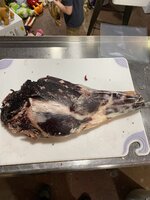
Genius!Yea when the fridge cycle kicks in to cool, the humidity drops a lot and rises as the temperature increases. I set the inkbird controller to 79.5 so when it’s below that it kicks on the humidifier and if it goes above that it kicks on the dehumidifier to maintain even humidity so it doesn’t spike as the fridge cycles. Without the controller plugged into the units inside, I was seeing as low as 60% at the bottom of the cycle and 96% at the top. When the units were plugged into the inkbird the swing was about 76 to 82%. I ended up setting the temp controller for 35-37 so when it hits 37 the cooling cycle kicks in, I first did 34-38 and the humidity spike was a lot even with the controller. 2 degrees for this fridge seems to be the sweet spot with keeping the humidity the most stable
Neumie
FNG
- Joined
- Oct 3, 2021
- Messages
- 78
This is extremely interesting! I dry aged a young whitetail buck just 5 days and think there’s a huge difference between it and previous animals that went from woods to table more quickly. The meat is firm, with nearly no blood. It was hung completely intact in my shed. Temps 30 nighttime and 35-40 daytime. I’m looking forward to trying some more time in the future but don’t think I can get over the idea of mold.
Another update on my aged whitetail from January. I ate a few of the last roasts yesterday for dinner. Was going to cook them up and mix in with some pasta, but decided to enjoy them for what they were. I cooked them medium rare in a cast iron skillet with butter, oil, and a few toppings. They were fantastic. When I get the opportunity to build a garage on my property, I will be setting a space aside for a walk in cooler. I would like to do this process with all of my game. It is well worth the wait.
Another happy Rokslider. Good to hear, and a walk-in cooler would only make the process easier. Good luck!Another update on my aged whitetail from January. I ate a few of the last roasts yesterday for dinner. Was going to cook them up and mix in with some pasta, but decided to enjoy them for what they were. I cooked them medium rare in a cast iron skillet with butter, oil, and a few toppings. They were fantastic. When I get the opportunity to build a garage on my property, I will be setting a space aside for a walk in cooler. I would like to do this process with all of my game. It is well worth the wait.
Last edited:
Similar threads
- Replies
- 18
- Views
- 946
Featured Video
Latest Articles
- TT#64 Josh Boyd Elk Hunting Strategies for Every Season
- Aaron Davidson of Gunwerks
- TT#63 Dirk Durham’s Art of Elk Calling
- BIG Buck Stories with the Dirty Giants Podcast
- TT#62 Brian Barney Hunting Bulls without Calling
- Hoyt Alpha AX-2 SD Review
- Kuiu Kenai vs Outdoor Vitals Vario Hooded Jacket Review
- Hoyt RX-9 Ultra Review
- Hunting Vampire Bucks & Building an Optics Kit
- Darton Sequel ST2 35 Review












